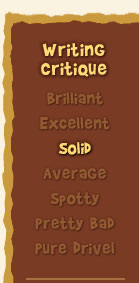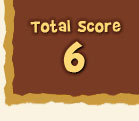|
 |




 |
Back Cover
(click for larger image) |
If you like this comic,
you might
also enjoy |
 |
Junk Comix |
REVIEW SCORE 7 |
|
Snapper #1

Only Printing / 1973 / 36 pages / Artists at Large

|
Snapper creator Gregg Miller's brightly colored cover art for the first issue hints at the troubling content inside the book, as it depicts an outdoor cinematographer on a steep mountain side at the exact moment that his tethered rope is snapped in two by an incongruously located alligator with a very dark sense of humor. Welcome to Snapper, the comic book that cuts you loose!
Inside the book, Miller begins with "Saturn and Goobie are Out on the Town," which features a young, hip couple trying to enjoy a pleasant dining-out experience. The couple is annoyed at their first restaurant of choice because dining guests have to sit on the floor for their meal. Saturn (the dude) gratuitously punches out a waiter and breaks a wine bottle on the restaurant manager's head before they leave in a huff. They like the next place they go to much better, so they get drunk and start fucking on their table in the middle of the restaurant, which leads to a giant brawl outside the restaurant. On their way out, Saturn and Goobie, who have zero social manners of their own, complain that people are so uncivilized.
"Out on the Town" isn't terribly funny, but it does have a certain sense of daring maliciousness about it. But the problems in this story are the same that will plague much of the entire series, which include the fact that Miller is a mediocre comics illustrator. He takes on challenging layouts and action scenes, but they are often executed crudely and with no apparent study of either perspective or human anatomy.
Now, I'm usually not the first person to bemoan a lack of conventional drawing skills in underground comics (I like Hayes, Kominsky, etc.), but if you can't draw a human body effectively, it helps to at least have a solid grasp of design. Good design requires appropriate balance, contrast, proportion and spacing, all leading the eye to points of emphasis (which both Hayes and Kominsky did pretty well). Despite some nice touches of detail, many of Miller's comic panels are flat and noisy and feel like they were thrown together without much forethought (or pencil work). Miller's better work occurs when the drawings aren't bound to reality and are allowed to explore surreal (and drug-induced) settings, which appear frequently in later pages of Snapper #1.
Miller is also more effective as a storyteller when he strips down his drawing to the bare essentials, like Bob Foster did in his best Myron Moose comics. Miller replicates this successful formula in his "Beaks" strips, which make sporadic appearances in both issues of Snapper and utilize a bare-bones illustration style that helps emphasize the writing. The first instance of "Beaks" shows up after the "Out on the Town" story and, as usual, features black birds engaged in witty sociopolitical discussions. The "Beaks" strips, which represent some of Miller's best work, also appeared in Miller's Ragu Too poetry book in 1972.
Following the first "Beaks" strip is "The Trial's The Error," a four-page story about a small-town trial of a man accused of rape. The story, contributed by David W.S. (full name is unknown to me), depicts the accused admitting to the crime but testifying that he thought the whole thing was a dream he had after smoking some good weed. Not a particularly good excuse. Worse yet, the victim is portrayed as an unsympathetic character (leading the reader to believe her accusations may have been unwarranted) and the delinquent jury ends up declaring the rapist not guilty.
The wording of the title "The Trial's The Error" is critical to understanding whatever satire is present in the story. It seems that David W.S. intends us to perceive that "a jury of our peers" may not be the best method for determining the innocence or guilt of a despicable defendant if the "peers" are equally reprehensible characters. Indeed, perhaps "the trial" by jury is "the error" of our justice system. I can see the cogs churning in that slightly warped logic wheel.
Even so,
"The Trial's The Error" portrays a rapist and his trial with a sense of amorality that few underground comics can match. The mere concept of a jury siding with an admitted rapist for any reason is a bit too much to bear. Perhaps the low point is when one juror declares, "Shit! We've all wanted that bitch." Even Robert Crumb didn't go quite that far. As the one who included the story in his comic book, feel free to blame Gregg Miller for any trespass of morality.
But fuck, this is underground comix, right? A medium that continuously trespassed traditional standards of morality to break the narrow mold of conventional comic storytelling. Miller is just continuing that great tradition, which he amply demonstrates in the hallucinatory stories that fill out most of the rest of the book.
In the epic, 12-page "Tell It Like It Is," Miller depicts three friends who go tripping in the "Mexican badlands," which leads to deadly encounters with eggs, giant penises spouting flames, flying through history with Christ on a crutch, and sex with a female Jesus named Christina. And that's just the tip of the phantasmagoric iceberg. The book closes with an equally surrealistic tale, the nearly wordless "The Border of Reality," which illustrates a hallucinatory drug trip with rocket ships, sharks and unnatural metamorphoses.
Snapper #1 is considered one of the many inferior undergrounds that comprised the glut of crappy comics in 1972 and '73 that helped lead to the demise of the underground comix era. And there's really no way to refute that belief. This book didn't sell very well back then, due to the fact that it not only featured a cast of unknown artists, but the artwork was also relatively crude and unpolished (though Lexi Prickett's one-page contribution is rather charming).
But Gregg Miller had a vision in the early '70s; some sort of optics that we can't entirely achieve in this century (at least without very illicit medications), but one still worthy of our consideration (and then perhaps our condemnation).



HISTORICAL FOOTNOTES:
It is currently unknown how many copies of this comic book were printed. It has not been reprinted.

COMIC CREATORS:
Gregg Miller - 1-8, 13-26, 28-34, 35 (collaboration), 36
David W. S. - 9-12, 35 (collaboration)
Lexi Prickett - 27 |
|
|